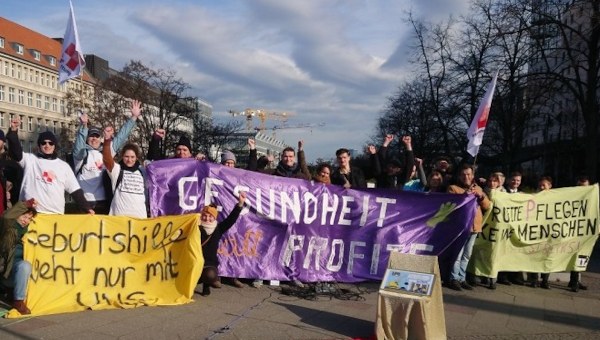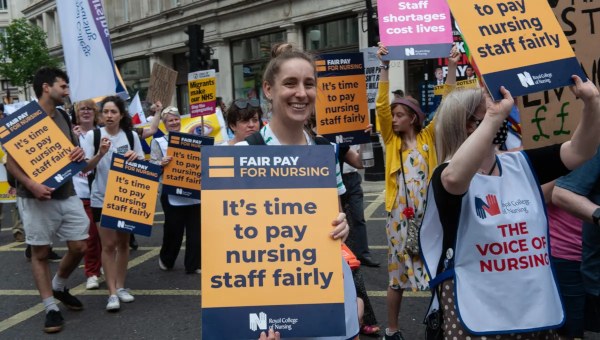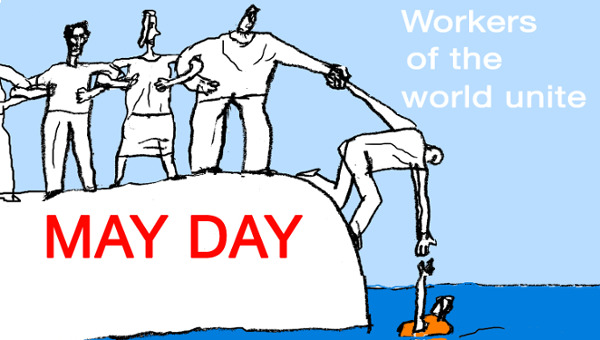Europe’s Hospitals on Strike: Different Countries, Same Labour Struggle
Germany Against Hospital Spending Cuts
In recent years, an increasingly broad and well-networked hospital movement in Germany has dispelled the myth that hospital strikes are impossible. This labour struggle was set in motion by the introduction of a new form of hospital financing. The so-called case-by-case flat rate system (in which hospitals receive fixed amounts for diagnoses rather than, as previously, for hospital stays – Fallpauschalensystem) led to immense pressure to cut costs in public hospitals. Hospital staff felt these cuts first: in 2012, Germany had the worst staffing ratio of trained nurses in Europe. At the same time, the average length of stays fell by half. The shortage of personnel, especially in nursing, took on proportions that dangerously undermine patient care in many places. This can be seen, for example, in reports on the shortage of intensive care beds for children.
The cuts to hospital spending immediately led to effective strikes in the healthcare sector. In 2015, the German service sector union Verdi won the first collectively bargained staffing settlement to ease the burden on employees at Berlin’s Charité hospital. Strike movements at 18 clinics across Germany followed Charité’s success. Some even made headlines, such as the strikes at the six university hospitals in North Rhine-Westphalia in the spring and summer of 2022. Lasting 77 days, they marked the longest strikes in the history of the German healthcare system. Numerous wards, including intensive care units, were completely closed for the duration of the action.

The strikes were based on a clear strategy: The employees, supported by union organizing, first formed teams and built up a willingness to strike. Their emergency service agreements between the union and hospital management now serve as tried and tested means of guaranteeing the right to strike even in critical infrastructure such as inpatient care. By closing off access to beds and wards, workers were able to put significant pressure hospital administrations. Social coalitions with patients and social movements, as in the case of the Berlin hospital movement, strengthened public support for the strike.
Hospitals in Germany are showing signs of movement: Unions in German healthcare are growing faster than in any other sector in the country. And in the current round of collective bargaining to increase pay by €500 for public service workers, hospitals have again positioned themselves front and centre by staging warning strikes.
Great Britain: The Largest Strike Actions since Thatcher
The recent mobilisations in the British healthcare system are part of the largest strike wave in the Great Britain since the Thatcher era. They have articulated the collective frustration of a healthcare and social system that has been cut to the point to collapse – spending cuts that have coincided with the greatest loss in real wages since 1977. The staffing shortage in hospitals illustrates the precarious conditions in the healthcare system. Striking nurses have been chanting “Safe staffing saves lives,” designating working conditions that have become increasingly hazardous to the health of the British population. The COVID pandemic exacerbated the already overstretched resources of a broken British healthcare system: Non-urgent operations were put on hold, and a system already on the brink had to cope with coronavirus infection waves over two consecutive winters. These pressures on the system have not abated. Overloaded emergency rooms have led to long waiting times and significant delays in ambulance pickups.

The largest hurdle for the current strike activity is the conservative appeal to hold out, coupled with a proposed law that will hamper the strength of industrial action in the future. The bill, if passed, would make it possible to limit strike activity. Healthcare workers could then be legally required to work, even during strike actions. This would effectively deprive workers of the ability to seek higher wages and better working conditions.
However, support for strikes is high, especially when undertaken by hospital staff. The demand for better working conditions, higher wages and less work pressure has majority support, especially for professions crucial to the system’s functioning. COVID has not only exacerbated tension in the British healthcare system: It has also raised the public’s awareness of the need for healthcare professionals. In addition, everyone has now been affected by inflation in some way. When healthcare workers strike for higher wages, there is more support now than at an earlier time when general prosperity was less widely threatened.
In Spain 70 Percent of Hospital Staff Go on Strike
Hundreds of thousands of people took to Spain’s streets in February to demonstrate against underfunding in the public health system. There are shortages in both equipment and staff. Family doctors and clinics are overcrowded. Current health crisis can be traced back several years to the aftermath of the financial crisis. In 2010, the Spanish government introduced austerity policies and implemented drastic spending cuts, including to the budgets of regional governments responsible for healthcare policy. 30,000 jobs were cut, wages were reduced and hospital beds were decimated.
During the Coronavirus pandemic, the precarious situation in hospitals had catastrophic consequences. The cuts were felt especially acutely in Madrid, where the right-wing regional government also pushed to privatize healthcare infrastructure. While patients were being turned away from public clinics due to lack of space, private clinics went unused. Occupational safety was disregarded, making hospitals into viral hotspots. At times, up to 20 percent of new infections occurred in hospitals. As the coronavirus crisis began, Spain recorded one of the highest excess mortality rates in Europe, with a total of over 120,000 people dying during the pandemic.

Since then, little has changed. And for this reason, beginning in November last year, there have been nationwide mass protests and strikes in the healthcare sector, reaching their peak in February. In Barcelona, 10,000 health workers took to the streets. In Madrid, well over 250,000 people – according to the organizers, up to a million – responded to the call, “Madrid rises up.” 70 per cent of healthcare workers participated in the strike. This enormous mobilisation strength can probably be explained by the protest experience built up since 2011 with the Spanish anti-austerity movement (Movimiento 15-M), as well as by the fact that the protests were strongly anchored locally in neighbourhoods.
In Barcelona, an agreement was reached for the current conflict, but in Madrid the situation continues to escalate. Instead of engaging with the strikers, the regional government is trying to undermine the legitimacy of the mass protest. It has not been above spreading false information about the precarious state of the healthcare system. Further strike days took place at the end of April and beginning of May.
Austria’s Wheels of Justice Grind Slowly
In Austria, the wheels of justice turn more leisurely than elsewhere. But here, too, the nursing crisis is acute: According to the Misscare study by the University of Vienna, 84 per cent of nurses report that they have to skip essential care steps due to lack of time. The state of the nursing debate, however, is still quite different. When the nursing shortage was discussed on the program “Im Zentrum” in December 2022, there was neither a nurse nor a trade unionist to be seen on the podium. Panellists spoke about nursing studies and new recruitment attempts in Columbia or Vietnam, but not about much-needed workload reduction. In order to achieve that, the state would have to invest the money to make the profession attractive again.
The unions should be leading this demand. Strikes in the healthcare sector have indeed taken place in recent weeks and months for the first time in quite a while, though they have been cautious. On November 22, 2022, employees from Vienna’s religious hospitals went on strike for just under two hours for a pay raise of €500. Employees in private hospitals staged a three-hour warning strike at 25 sites across Austria on February 14 after the sixth round of negotiations with employers failed.
One exciting case is Linz University Hospital, Austria’s second-largest hospital. Employees have been demanding a reduction in their workload for years, and at the end of January, the works council made an open threat to go on strike in the summer. Hospital management then offered to negotiate with the works council and the union, which should bring relief by the summer. The strike is therefore off the table for the time being, and the outcome of the negotiations remains unknown.
One thing is clear: In the long term, the employees’ demands can only be resolved through a political confrontation. Without a credible threat to build up pressure in the healthcare sector through strikes lasting several days, not several hours, the nursing staff and workers in the hospitals will have their backs to the wall. •
This article first published in English on the transform! website and in German on the Mosaig blog.





